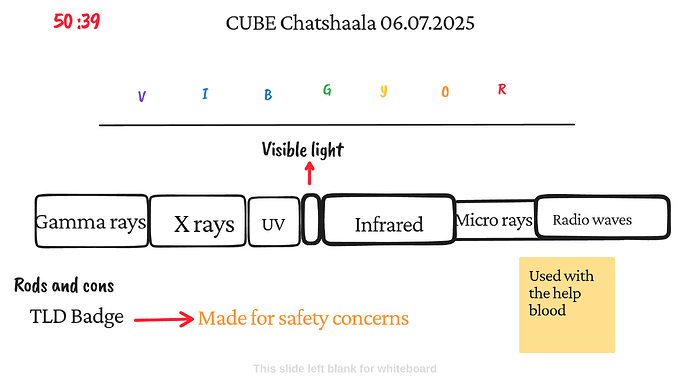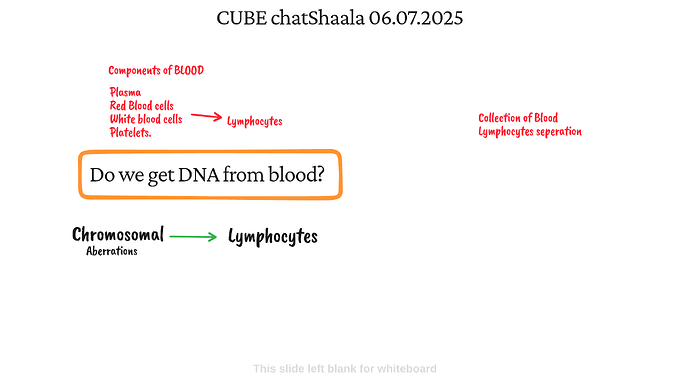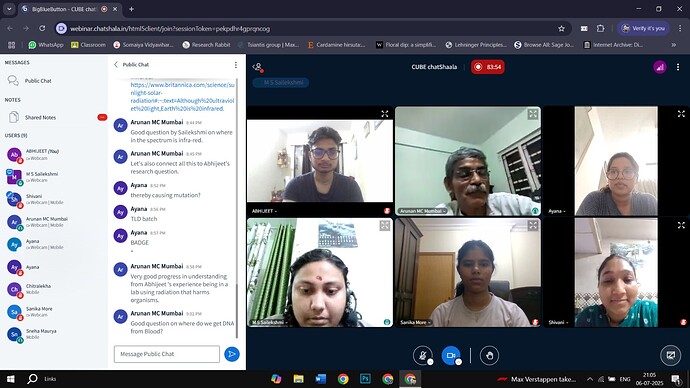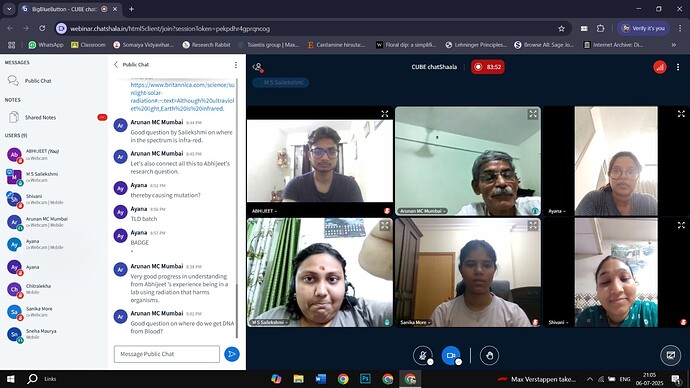 Participants and Highlights
Participants and Highlights
-
Sailekshmi ( CUBE @ S N College Chempazhanthy ) shared ongoing mustard seed germination studies, comparing different sprouting setups and chemical treatments ( notably using 10% KOH to observe setae in earthworms ).
-
Abhijeet ( Bio Dosimetry Lab ) brought in a thought-provoking discussion on DNA damage response mechanisms, tying it to electromagnetic radiation exposure—a theme directly linked to radiation safety in lab environments.
 Core Concepts Explored
Core Concepts Explored
1. What is DNA?
![]() Explored as a molecule composed of:
Explored as a molecule composed of:
![]() Sugar-phosphate backbone
Sugar-phosphate backbone
![]() Nitrogenous bases : Adenine (A), Guanine (G), Cytosine (C), Thymine (T)
Nitrogenous bases : Adenine (A), Guanine (G), Cytosine (C), Thymine (T)
This led to discussion on molecular structure and function in living organisms.
2. Role of Radiation in DNA Damage
The electromagnetic spectrum was discussed, with a focus on:
![]() Gamma rays, X-rays, and UV ( high energy – damaging DNA )
Gamma rays, X-rays, and UV ( high energy – damaging DNA )
![]() Visible light ( VIBGYOR ) – placed between UV and Infrared
Visible light ( VIBGYOR ) – placed between UV and Infrared
● TLD Badges ( Thermo Luminescent Dosimeters ) were mentioned as safety tools used in radiation labs to monitor exposure.
3. Can We Get DNA From Blood?
A pivotal question raised:
" Do we get DNA from blood? "
Clarified that:
-
Red Blood Cells (RBCs) lack nuclei → no DNA
-
White Blood Cells (WBCs), specifically lymphocytes, have nuclei → DNA can be extracted
Discussed the process of blood collection and lymphocyte separation, relevant for chromosomal aberration studies and genetic analysis.
 Group photos during ChatShaala
Group photos during ChatShaala
 Follow-up Questions for Inquiry-Based Exploration:
Follow-up Questions for Inquiry-Based Exploration:
-
 Why might mustard seeds be an ideal model for studying Mendelian genetics in seed germination?
Why might mustard seeds be an ideal model for studying Mendelian genetics in seed germination? -
 How exactly does electromagnetic radiation damage DNA at the molecular level?
How exactly does electromagnetic radiation damage DNA at the molecular level? -
 What methods can be used to isolate lymphocytes from blood for DNA extraction?
What methods can be used to isolate lymphocytes from blood for DNA extraction? -
 Why do TLD badges glow under radiation exposure, and what material science principle lies behind it?
Why do TLD badges glow under radiation exposure, and what material science principle lies behind it? -
 Can seed germination data ( like in the mustard study ) be used to understand genetic variability or mutation patterns?
Can seed germination data ( like in the mustard study ) be used to understand genetic variability or mutation patterns?
 Reference
Reference
Let’s keep the spirit of “ context to curriculum ” alive by transforming everyday observations and simple biology into deep, inquiry-based science!
@Arunan @Ayana_Sudheer @Shivani @Abhi0703 @2020ugchsncnseethala @Chitralekha @magpie and others.





